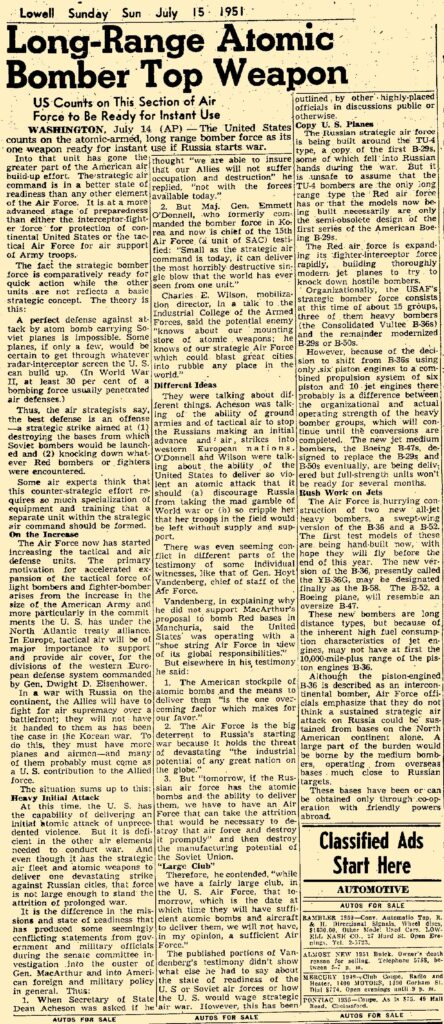After the Soviets detonated their first A-bomb in 1949 and continued to impose their political will in Europe, the United States developed a strategy defined by the objectives of the Strategic Air Command, SAC. The ground rules of this response is described on this page.
The essence of this US national response is succinctly described by the following newspaper insert below.

Attribution: The Lowell Sun – 7-15-1951 , page 23
In essence, the warring parties in Moscow and Washington agreed that every city in the Soviet Union with a populaton of 100,000 people or more and, correspondingly, every such city in America would suffer nucear destruction should war break out between us. Since, my home town of Lowell, Massachusetts had a population of about 100,000 persons at the time, this mutual understanding took on a very personal connotation.
We were, indeed, at a nuclear standoff.
B52 SAC Super-Bomber
The reader can get an idea on the performance of this intercontinental, jet-powered aircraft by studying the article given below.
Aircraft Type: B-52B(RB), S/N 52-8711, Stratofortress, Boeing
Mission: Heavy Bomber
Number Built : The Air Force purchased 744 B-52s- prototype, test, and reconnaissance configurations included. Precisely, the B-52 program counted 1 XB-52, 1 YB-52 (first flown on April 15, 1952, almost 6 months ahead of the experimental B-52), 3 B-52As (restricted to testing), 50 B-52Bs (27 of which could also be used for reconnaissance), 35 B/RB-52Cs, 170 B-52Ds, 100 B-52Es, 89 B-52Fs, 193 B-52Gs, and 102 B-52Hs. Six years of development preceded the beginning of production which, after a slow start around 1953, did not end until October 1962.
Powerplant: Eight Pratt & Whitney J57-P-29W turbojet engines, 10,900 lbs. thrust each.
Weight: Empty 175,000 lbs., Loaded 420,000 lbs., Maximum takeoff weight 420,000 lbs.
Dimensions: Wingspan 185′, Length 152’9″, Height 48’3″.
Performance: Maximum speed 612 MPH at 40,000 feet, cruising speed 565 MPH, service ceiling 47,000 feet.
In contrast, the Soviets also had a long-range bomber called the Tupolev_Tu_160, which could deliver heavy payloads over long distances.
These were dangerous times, but we youngsters, boys and girls, could not fathom the breath-taking extent of the upcoming East-West nuclear confrontation that challlenged us. Adults around us were equally misinformed about the reality of thoe days.
For young boys familiar with the historic gunfight at the OK Corral in Tombstone AZ, circa 1861, the anticipated duel described here seemed to be more adventurous on a global scale than the Tombstone case.
The reader is asked to recall that most residents in the city of Lowell had long family histories emanating from quiet, rural farm-life in Quebec, Poland, Greece, Lithuania, Portugal, etcetera, etcetera. For these folks, indoor plumbing, the light bulb and a telephone at home were marvels of the industrial world.
However, deadly, radioactive fallout coming from nearby nuclear atmospheric explosions were issues far removed from their daily experience.
Curiously, however, the nearly infinite depth of US, popular ignorance regarding the anticipated, disastrous consequences of a mutual, nuclear war with the Soviets proved itself as a hollow, imaginary shield guarding the flock from grim reality.
Alfred E. Neuman, when he was not running for President, comically evoked in every American child the belief that our national anxiety over nuclear events was too far-fetched to be taken seriously. Mad Magazine, Alfred’s magazine editor, had successfully transformed this cartoon character into a national hero. During our high school (1953-1957) years, my friend, George Bourbeau, and I had discovered this “truth-teller” in the pop culture of the times.
The widespread, popular fear generated by the likes of Dr. Edward Teller, the father of the H-bomb, and the folks at the Strategic Air Command, SAC, coud be neaty countered by one quiet reading of Neuman’s famous rhetoric: “What? Me worry?“.
Newsstands across the globe now could counter the negativity of the military-industrial complex that was working Wall Street into a frenzy.
However, those scarry days of “Duck and Cover” were just around the corner.
